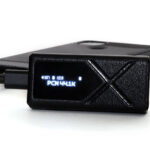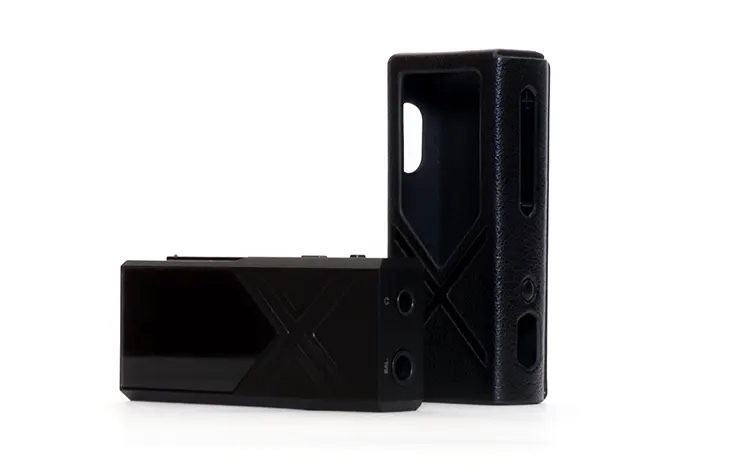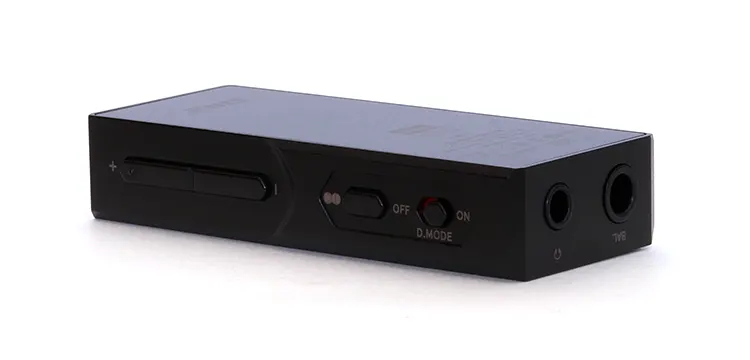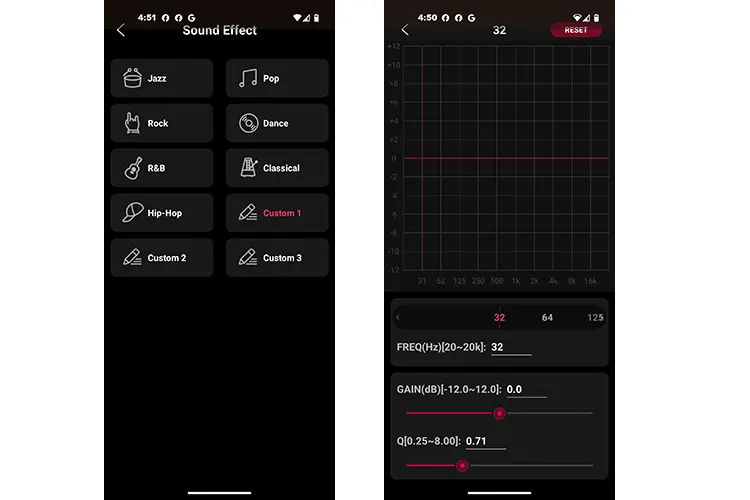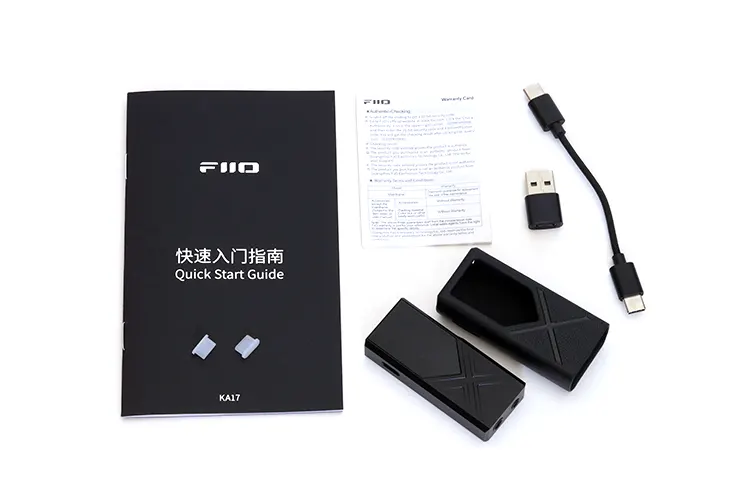In this feature, Louis reviews the FiiO KA17, which is the company’s flagship dual ES9096Q dongle DAC capable of up to 650mW of balanced output power. It is priced at $149.99.
Disclaimer: This was sent to me as a sample in exchange for my honest opinion. Headfonics is an independent website with no affiliate links or services. I thank FiiO for its support.
You can click here to learn more about the FiiO audio products we have previously assessed on Headfonics.
Note, that this post follows our current scoring guidelines which you can read in more detail here.
FiiO recently released a new dongle DAC, the KA17, which not only takes the TOTL position from the KA5 within their current dongle DAC lineup but also has the claim of being their most powerful dongle DAC yet, superseding the 550mW capable KA13.
FiiO seems to have crammed a collection of well-known components combined with new tech inside the KA17 that will more than likely perform well in most situations. It also comes in two color schemes, black and blue, and is priced at $149.99.
The FiiO KA17 offers surprisingly good audio quality and quickly became one of my favorite dongle DACs in this price segment.
My full review below fleshes out how the KA17 performs in more detail and why I came to that conclusion.
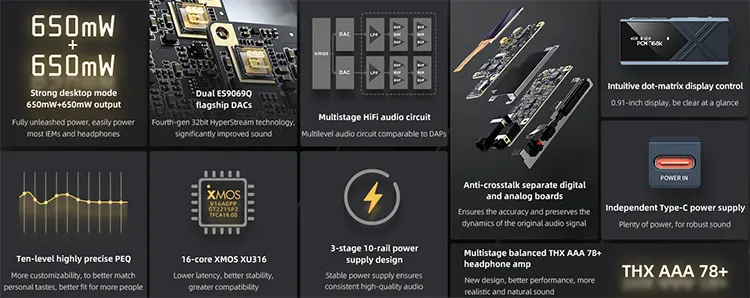
Features
FiiO stuffed the KA17 with lots of goodies starting with a pair of fourth-generation ES9069Q flagship DAC chips which are mounted within a multistage HiFi audio circuit that seems to be based on dual mono architecture starting back at the DAC section and beyond the USB circuitry.
Decoding
The DAC section is initially fed by an XMOS 16 core XU316 which is a common component nowadays that gives good results for low latency and high bit rate management.
The FiiO KA17 can deliver up to 32bit 768kHz, native decoding up to DSD512 and DoP256. There’s also MQA full decoding for those that still use it with SPDIF output support at up to a maximum of 32bit/96kHz.
Amplification
Beyond the DAC section lies a dual low-pass filter stage that carries the signal over to the analog portion of the circuitry stage. Most of the circuitry stages are multistage within this model.
FiiO chose to use a THX-certified AAA 78+ multi-stage amplifier section featuring a similar setup used inside the M11 Pro which I’m happy about. This is an eight-opamp, four-channel fully balanced configuration setup that can deliver up to 650mW per side on a balanced 32Ω load.
Component arrangement
The FiiO KA17 is one of the most advanced dongles I’ve seen due to its various implementations. For example, FiiO separated the analog and the digital stages on separate boards. This design along with its complex power delivery circuitry is a contributor to the KA17’s ultra-noise floor.
The power supply section is an interesting one and is largely responsible for the KA17’s hiss-free operation. It’s a 3-stage 10-rail power supply design with 8 Tantalum capacitors along with over 10 thin film capacitors.
There’s overload protection, a second stage DC to DC conversion, and a stack of precision LDOs.
Most of the components are doubled up including the dual frequency, dual crystal oscillators. The only component that is a single unit seems to be the 0.91-inch OLED dot-matrix display, the XMOS, and the chassis itself.
Design
The FiiO KA17 seems to be built similarly to the BTR7 in that the body is made from aluminum and tempered glass. There’s a back plate, a main body that seems to be CNC-shaped from a single chunk of aluminum, and a sheet of tempered glass to protect the OLED screen.
It’s the typical dongle DAC shape but it’s a bit chunky and it’s almost the same size as a BTR5 2021. I do prefer the BTR5 build over this one.
The reason is that this dongle has some sharp corners and edges that could annoy the user if it’s placed too close to the skin. The corners are the most offensive here, but FiiO includes a protective case so, rewind the tape and forget the sharp corners. The problem is remedied by FiiO out of the box.
I/O
The FiiO KA17 IO consists of a female USB-C connection on the input side and dual headphone connections on the other end. The 3.5 is also equipped with SPDIF output capability but, you’ll have to outsource an adapter. Any common 3.5mm SPDIF adapter will do in this case.
The two headphone connections consist of a 4.4mm balanced output and a 3.5mm single-ended output. Both connections are controlled by the onboard rocker-type volume control. There’s also a two-level gain control and a desktop mode.
The volume control also has two volume position sets, a 60-position, and a 120-position setting which is excellent for making finite control. Most people will just leave the dongle on 120 like I did so that’s a set-and-forget feature.
The KA17 has one feature that’s rather unique in this segment. There’s an additional USB-C tap on the side of the dongle supplying parallel power enabling this dongle to produce more power on tap on the output side as well as saving your phone’s battery life.
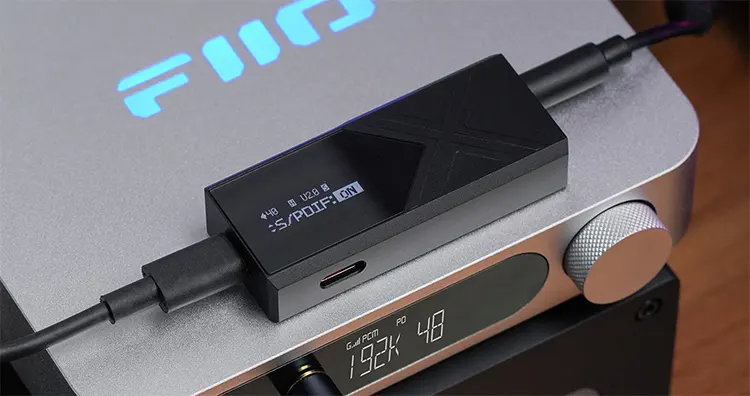
Onscreen Menu
One of the most intriguing features available within the FiiO’s KA17’s menu is a set of eight selectable digital filters along with twelve EQ presets. That’s a lot of sonic control.
Then comes the volume step adjustment with a selectable 120 steps of volume adjustment as well as an additional balance adjuster.
The display includes other features like a dimmer, a max volume setting, a display time off adjustment, a USB 2.0/1.0 selector, a language selector, and a couple of other features.
The menu is easy to access and navigate as well. It’s activated by a 3-second press of the multifunction button and the same is used to scroll through all the features. The volume control selects the setting of each feature.
FiiO Control
You should be familiar with FiiO’s Control app by now. It’s a full-featured app that depending on what device you have connected to your mobile device, the app will open up pertinent features accordingly.
My unit for some reason would keep asking me to activate the internal EQ but when I did, I would get a hard reboot from the unit itself so I could not use this app properly at first. The EQ was off by default. Understood.
There’s a feedback link within the app that allows you to report any bugs and I did just that. I might have done something wrong. Yep. I certainly did. I was disabling it.
After a long period of trial and error, I realized that you have to set the EQ to one of the defined preset settings but you must go in the other direction because Up on the volume will give you the disable and the reboot thereafter.
Press Down while in the menu, choose a preset and the Parametric EQ will start to work for you within the app appropriately.
Ten presets are available with three of them being user-adjustable curves. However, the system must be set below 192kHz/24bit for the Parametric EQ to be enabled and it doesn’t work on USB.1.0 mode.
Packaging & Accessories
There’s one unique aspect about the included accessories that come with the FiiO KA17 which are the USB covers. I’ve been wondering why these types of plugs haven’t been included before. But we still need one for the unused headphone plug. Maybe next time.
The rest is standard stuff. A four-inch dual USB-C cable is included which is bungee cord cloth wrapped plus you also get the type A adapter for full-size USB connectivity.
Another nice touch was the included cover which matches whatever color of KA17 you chose. The rest of the inclusions are composed of literature. There’s a warranty information card and a quick guide.
Sound Impressions
The HIFIMAN HE400se was used to test the KA17’s ability to push hard-to-drive cans correctly. The SIVGA SV023 was also used which is a 300Ω dynamic driver headphone.
I also used a HIFIMAN Sundara with Fenestrated Dekoni pads. All the gear was used with stock cables except for the Sundara, where a custom OCC cable was used to test the balanced 4.4mm output.
IEMs used were FiiO’s own FH9, the FH7s, and the FD7. Other IEMs used were the ORIVETI OD200, the HIFIMAN Svanar, and the Kinera Imperial URD.
Summary
I immediately recognized the overall sonic signature of the FiiO KA17 since I occasionally use my FiiO M11 Pro which has a similar internal component lineup except for the DAC implementation.
The new DAC section does improve things, especially with soundstage capability and tonal response.
The M11 Pro has a very aggressive tonality and lots of forwardness attributed to its highly energetic sonic character which tends to bring forth detail.
The KA17 has similar characteristics but FiiO tamed the intensity down and kept all the positive qualities. It also seems that there is less hiss present overall.
The KA17 also has less of that dry-sounding bottom end and it now has more body and texture overall, more than likely attributed to the updated and improved DAC section.
The frequency response seems super linear and extends both ways very well. The KA17 has a dynamic and fast-sounding character that remains coherent when tracks get complex. Again, a common character of a good DAC section.
Staging and Dynamics
I was pleasantly surprised at the staging performance of the KA17 and is one of the best I’ve heard in this gear segment. It’s open, precise, and has good depth and multipoint placement.
The KA17 staging has a very tall presentation, however vocal and center stage seem reduced in size, intimate, and right below the chin line. But that helps at times to turn vocals into focal points.
The KA17 can turn a headphone like the HIFIMAN HE400se into a great performer, stage-wise, which requires a decent amount of current and gear that not only can supply the power but also ample imaging precision.
Click on page 2 below for my recommended pairings and selected comparisons.


